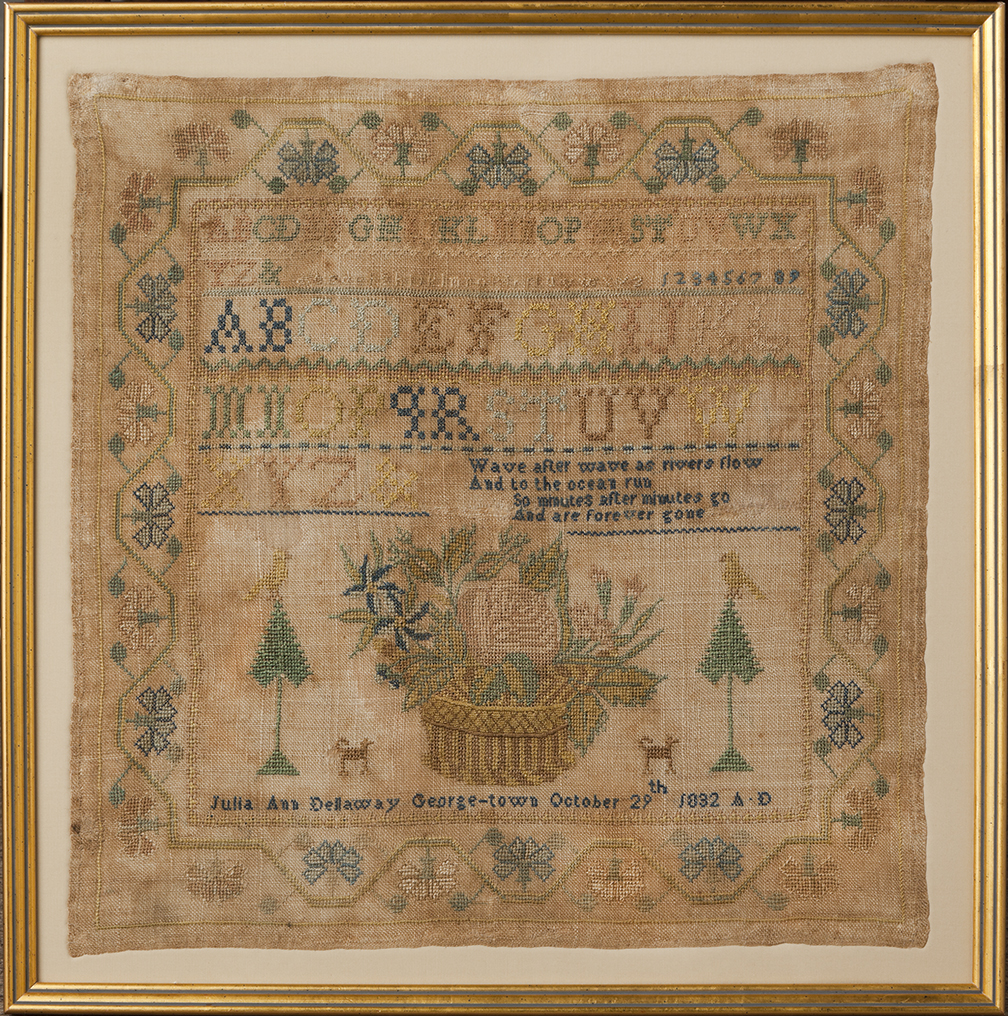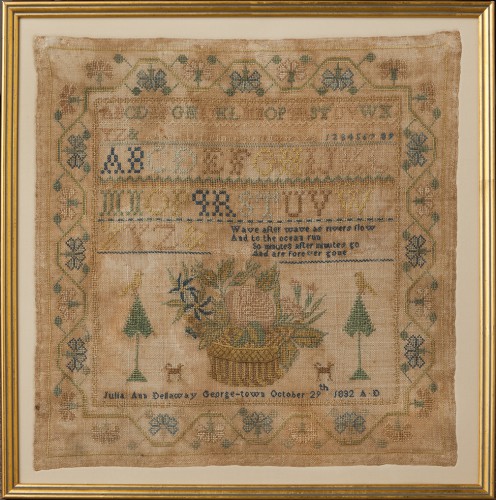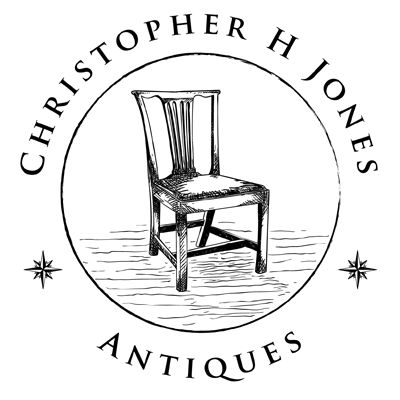1832 by Julia Ann Dellaway
Georgetown, Washington DC
Silk on linen
Commentary: Julia Ann Dellaway was the daughter of Captain John Dellaway, a seaman who appears to have been away at sea much of the time, sailing out of the port of Georgetown. Period newspapers in 1833 and 1834 report Captain Dellaway in charge of the Brig Rubicon which travelled between New York and Georgetown and likely other ports as well. By 1841 John Dellaway was a master of steamers working in Florida for $80/month and in 1843 he was back in Washington as a “master of transports.” In 1847 he is listed on the propeller boat Ed Stanton in the Gulf of Mexico, earning a salary of $150/month. By 1853, J. W. Dellaway had retired from the sea; in the DC City Directory he is listed as proprietor of a “Segar Store” on the south side of Pennsylvania Avenue between 12th and 13th Streets.
Captain Dellaway’s nautical interests are reflected in the verse Julia Ann Dellaway chose for her sampler: “Wave after wave as rivers flow/And to the ocean run/So minutes after minutes go/And are forever gone.”
In the 1834 Georgetown directory, John Delloway, seaman lived on Jefferson Street, east side. Jefferson is a short street connecting today’s M Street to the waterfront. Census records in 1840 indicate that John Delaway, his wife, two daughters aged 10-15, and two daughters aged 15-20 lived in Georgetown and that he was employed in navigation. In addition to Julia Ann, two daughters have been identified through the DC marriage license records: Adeline Dellaway, who married John Wood Rankin in 1841 and Virginia Dellaway, who married Edwin Edmonston in 1850. A Julia Ann “Deleware” is listed, who married Benjamin M. Wall in 1841. The trail runs cold for all of the Dellaway girls after this, and remarkably little is known about the family beyond these bare facts.
More interesting than the Dellaway family history perhaps, is the link this sampler provides to other Georgetown and Washington area samplers of the period. One, dated 1831, is by Mary Ann Scott, identified as a student at the Georgetown Female Seminary, located just three to four blocks from the Dellaway home. Identical trees occur in both the Scott and Dellaway samplers: stylized pine trees with the terminal branches elaborated by the use of several extra stitches. Both samplers illustrate the trees on triangular mounds, and both depict large, tropical looking birds with contrasting beaks and legs. A third Georgetown sampler now in the collection of the DAR Museum in Washington DC by Artridge Priscilla Jackson and dated 1829 also features this style of tree, minus the mounds and birds, but sharing almost every other feature with the Scott sampler.
Dr. Gloria Seaman Allen is currently conducting research for an upcoming publication on Washington DC samplers. Her research suggests that this particular combination of trees, birds and mounds is indicative of a larger regional school, with samplers using the same motifs worked by girls near the Washington Navy Yard. A sampler by Julia Ann Crowley dated 1809/1810 with “Washington Navy Yard” stitched across the bottom features identical spade shaped trees with birds on top. The Navy Yard group samplers share earlier dates in the 1810’s.
Other communities in the mid-Atlantic region also have similar combinations of birds, trees and mounds. The spade shaped trees may have originally come out of the Philadelphia area. Samplers from Lebanon, Pennsylvania and the Susquhanna Valley exhibit these features. Teachers and traditions came to the area with the movement of the federal government from Philadelphia to Washington in 1800, looking for new opportunities and patronage as the new Federal City expanded.



